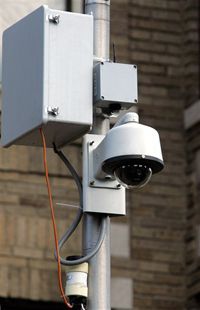By MATTHEW VERRINDER
The Associated Press
 A small gunshot sensor, with an antenna, top right, can be seen mounted on a pole just above a camera. The gunshot sensor triggers the camera via the control box at left. (AP) |
EAST ORANGE, N.J. — Barney Wright remembers a night three years back when the body of a young man was found in the weeds on Lenox Avenue hours after it was filled with bullets — only because someone walking by heard his cell phone ring.
Wright says no one on the street bothered to call police about the gunshots; Residents had gotten too used to the constant pops outside their open windows from gang drive-bys, drug deals gone bad and fights over prostitutes.
A year later, city police started to reclaim the Lenox Avenue neighborhood. They hung cameras and gunshot sensors on utility poles, like those used to weed out snipers in the Middle East.
The sensors, each about the size of a coffee can, are remarkably sensitive and accurate. For example, they can tell dispatchers the location of gunfire to within 60 feet, the difference between a 9 mm Beretta discharging and a firecracker exploding and even give a window into the mind of the shooter.
Since the sensors went up, Wright says he hasn’t heard any shots.
“The police came, put those things up, and the drug dealers left and haven’t been back,” Wright says. “Nothing happens here anymore.”
Including Lenox Avenue, police put up 93 sensors and 18 cameras covering about half of this 3.9-square-mile city, which once had a main drag known as the “Fifth Avenue of New Jersey” that was transformed after race riots gutted neighboring Newark.
Police Director Jose Cordero says the sensors and cameras have helped reduce crime 38 percent and shootings 30 percent so far this year compared to 2006. The city has nearly halved its murders from 17 in 2004 to nine last year, Cordero said.
It cost the city about $150,000 for the technology, although it a received a considerable price break from the companies who designed and installed the equipment as a demonstration for other cities, said Lt. Chris Anagnostis.
Also helping is a “Virtual Community Patrol,” which gives some residents in the city’s roughest areas access to a Web site showing panoramic views of their neighborhood through the cameras, so they can use their computers to report crimes in progress.
At headquarters, a team of dispatchers monitors screens that look through the cameras, which they can move in every direction and zoom in up to three miles away, allowing them to look at the city’s toughest sections and relay problems (or false alarms) to patrol cars.
Cities including Oakland, Washington D.C., Chicago, Los Angeles and Minneapolis, among other small- and mid-sized cities, are also using the sensors and cameras. Birmingham, Ala., a 160-square-mile city of about 240,000 people, paid $987,000 for 100 sensors to cover its roughest parts, said Police Capt. Ray Tubbs.
Residents in Birmingham, a city made up of a patchwork of 99 neighborhoods where many people own guns legally, had become fearful about reporting gunfire because of retaliation and were angry that it took police too long to respond, after the shooter had fled, Tubbs said.
He said the sensors, which can store gunshots to a server for analysis, will eventually be able to tell dispatchers what the shooter might have been thinking. A single shot could mean the gunman fired and ran away. A series of pops followed by a pause and then one more means the shooter could have fired wildly, hit his target, and then moved in for the kill.
“We’ll get a better sense of what we’re sending our officers into, because that’s critical,” Tubbs said. “Gunfire is fairly common here.”
It has become almost nonexistent in the worst parts of East Orange. Police Director Cordero said the only gunshot on Lenox since the cameras and sensors went up was a celebratory round fired off last New Year’s Eve, near a condemned apartment complex halfway up the block that used to be the main spot in the city to get heroin and crack cocaine.
“If you came here three years ago, there used to be like three gunshots a day,” said Eric Smith, 21, who lives near the apartment building. “It’s not like it used to be back in the day.”
Copyright 2007 Newsday Inc.









